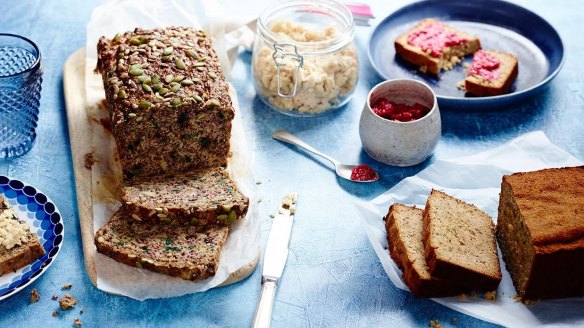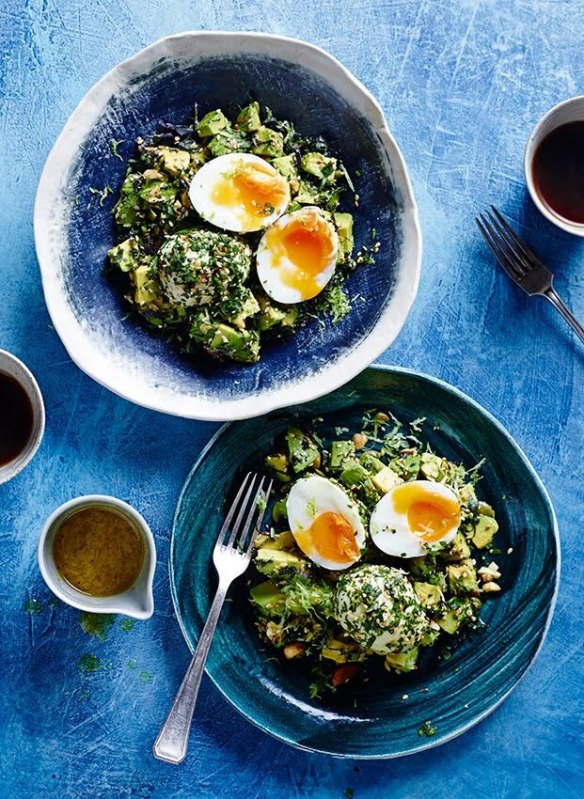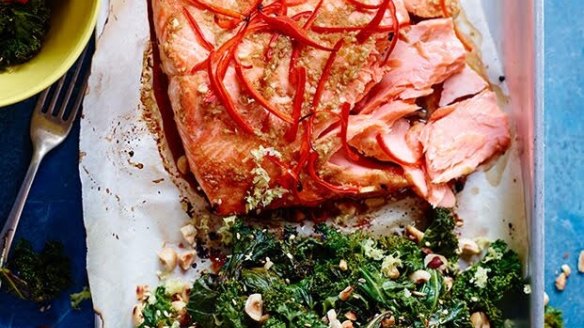To carb or not to carb? The experts weigh in

Love sweet potato fries but avoid pasta like it's the plague? Between the "zucchini crisis" in the UK that left clean eaters panicked without a carb substitute and the latest "Carb Cycling" trend in the US where people eat to a strict carb cycle to cheat their body into not storing carbs as fat so they can continue to enjoy them, it seems we're in a modern day diet dilemma: to carb or not to carb?
In Australia, our diet guidelines are changing too – where once we were told to avoid fats and eat carbs, now plant sources, "grains" (renamed from carbohydrates) and protein are the primary components of the 2017 Australian Healthy Eating Pyramid.
Yet despite updated information, the latest CSIRO Healthy Diet Score survey reveals Australians are still eating more discretionary foods (high in saturated fats, sugar and refined carbohydrates) than ever before, amplifying risk of weight gain, high cholesterol and blood pressure. So, when it comes to carbohydrates where do they fit in today's "clean" food culture?
Last month the CSIRO launched a "Low Carb Diet'' approach after combined research revealed a protein and unsaturated fats diet was highly beneficial for those either suffering type 2 diabetes or at risk of developing it. Not only did those reducing carbs showed greater improvement in blood cholesterol but also reduced their medication significantly too.
But what about the comfort it brings? Well, while tucking into a hearty bowl of pasta feels good at the time, Columbia University has found it may not be so great for happiness after all. Comparing the diets of 70,000 post-menopausal women, those eating refined whites were found to experience reduced blood sugar levels, mood swings, fatigue and other symptoms associated with depression.
Yet despite evidence backing the "clean carb-free" movement – if you're not out to lose weight, aren't managing diabetes or post-menopausal symptoms, is it still the right way to go?
Sydney based dietitian Dr Jo McMillan believes we needn't cut them for good, just understand how they can help or hinder our gut health.
"Refined carbs are not good for us. There is a definite link between eating junk food (high in refined carbs and saturated fats) and mental health and often this can be mitigated through changes to the gut microbiota," says McMillan.
"The gut needs fermentable fibres like whole grains, legumes, fruits, vegetables, nuts and seeds in order to create a healthy microbiota and to experience better immune, mental and gut health outcomes," says McMillan. "If you follow low carb, you risk affecting the gut microbiota as gut bugs can't ferment carbs and ferment protein instead. This can lead to toxic by-products (aka smelly farts!) and potentially disastrous colon health and inflammation levels."
Professor Arne Astrup of the University of Copenhagen also agrees carbs are still there to be loved as long as your body can handle them. "I am pro-carb if that means low GI, high fibre and wholegrain carbs. If someone can metabolise carbs and feel the satiating power of carbs that's great, but if someone is obese or slow to metabolise carbs I recommend majorly cutting back and going for a fat and protein, paleo diet."
Both can agree it's down to knowing good versus bad carbs. "Refined carbs are essentially sugar and starch without fibre and whole grain, so they are in no way good for our health. The best way to distinguish them is by looking at the glycaemic index, fibre and whole grain content," advises Astrup. "Choosing low-GI carbs will reduce risk of obesity, type 2 diabetes, cardiovascular disease, acne, aggression and depression."
What do low GI carbs look like? "Anything that's full of fibre and whole grains such as oats, rye bread, cabbage, apples and pears," says Astrup.
In terms of diet, Astrup believes we need to understand our metabolic type to lose weight. His latest research with the University of Copenhagen has found diagnosing your metabolic type through a blood test (type A being someone who loses weight by cutting fat, type B from eating low carb diet and type C from eating protein and fat) could be the best bespoke way forward in the future.
On the other side of the debate, Professor Grant Schofield, Professor of Public Health at the Auckland University of Technology who has co-authored What the Fat suggests a low carb, low sugar and high in healthy fats diet is the most sustainable diet approach.
He argues while there are three macronutrients – carbs, fats and proteins, only fats and protein are essential for human function: "We need a small amount of sugar in our blood but we don't have to eat carbs to get it. We can scavenge glucose from fats and proteins so while dietary carbohydrates can provide energy for humans, it's not compulsory – there is no such thing as carbohydrate deficiency syndrome."
Schofield says from a medical perspective it all comes down to insulin levels. "Carbs raise metabolic hormone insulin, and the extent they raise your insulin depends on how 'insulin resistant' you are. We all vary depending on stress, poor sleep, lack of exercise/sitting, sugar and alcohol, smoking and lack of sunlight etc," says Schofield.
"While someone insulin sensitive can chow down carbs and be perfectly okay, for an insulin resistant person high carbs means high insulin which leads to your body turning off fat burning and promoting energy storage. This then becomes the root cause of major metabolic problems – obesity, diabetes, cardiovascular disease."
Instead, by filling up on good fats such as avocados, high fat dairy and olive oil Schofield says you can access a great energy source without stimulating insulin.
What does a low carb diet look like then? And just how easy is it to wean off the white stuff and still get enough energy? Luke Hines, Sydney-based personal trainer, co-author of the Clean Living cookbook series and author of new cookbook Eat Clean believes it's all down to offering healthier swaps.
"I've had personal training clients come to me addicted to highly refined, sweet cereals, heavy white bread lunches and high starch dinners but after following a low carb, high good fat diet I have seen an improvement in energy, weight loss and mental clarity," says Hines."The key is offering easy replacements that taste delicious and have a similar mouth feel or look such as nutrient dense nut and seed granola instead of cereal or spiralised zucchini instead of spaghetti. It tricks you into filling the plate with more vegetables in a tasty way."
Keen to curb the carb cravings this winter? Try these clean and easy meal swaps from Hines' latest cookbook Eat Clean.
BREAKFAST

Swap a bowl of cereal for…
Avocado breakfast salad with herbed eggs
"Avocados are a great source of good-quality fat that have an amazing way of keeping us feel satiated for longer so you don't go reaching for naughty mid-morning snacks."
- 4 eggs
- 1 tablespoon finely chopped flat-leaf parsley leaves
- 1 tablespoon finely chopped coriander leaves
- 1 tablespoon hazelnuts roughly chopped
- 1 tablespoon cashew nuts roughly chopped
- 1 tablespoon almonds roughly chopped
- 1 tablespoon pumpkin seeds
- 1 tablespoon sesame seeds
- 2 large avocados, roughly chopped
- 1 small handful of kale, finely chopped
- 2 tablespoons avocado oil
- zest and juice of 1 lemon
- sea salt and freshly ground black pepper
1. Lower eggs into a saucepan of boiling water, reduce heat to a simmer and cook for 3-6 minutes depending on how firm you like them. Drain, peel off the shells under cold running water. Leave to cool.
2. Place finely chopped parsley and coriander in a bowl, add the peeled eggs and roll them in the herb mixture to coat them all over. Set aside.
3. In a separate bowl, toss together the nuts, seeds, avocado and kale until well combined. Dress evenly with avocado oil and lemon juice then season with salt and pepper.
4. Divide the salad between two serving bowls and top with boiled eggs.
Serves 2
LUNCH
Swap a white bread sandwich for….
Chia and zucchini hazelnut bread
"This phenomenally tasting, nutrient-dense paleo bread is a staple! The zucchini makes it really moist and the chia seeds add protein and iron making every slice worth its while."
- 130 g (1 cup) arrowroot or tapioca flour
- 200 g (2 cups) hazelnut or almond meal
- 60 g (1/2 cup) chia seeds
- 1 teaspoon bicarbonate of soda
- 1⁄2 teaspoon salt
- 2 tablespoons pumpkin seeds
- 2 tablespoons sunflower seeds
- 6 eggs
- 2 teaspoons apple cider vinegar
- 300 g grated zucchini
- 2 tablespoons finely chopped black olives
1. Preheat the oven to 160°C and line a 450g loaf tin with baking paper.
2. Combine arrowroot flour, hazelnut meal, chia seeds, bicarbonate of soda, salt and half the pumpkin and sunflower seeds in a large bowl. In a separate bowl, whisk the eggs lightly with a fork and stir in the apple cider vinegar, grated zucchini and chopped olives. Combine the two bowls and mix everything together using a spoon to form a nice thick and slightly wet dough.
3. Pour the dough into a loaf tin and sprinkle over the remaining pumpkin and sunflower seeds.
4. Bake in the oven for 1 hour or until golden on top. To test, press down gently on the top of the loaf – if it holds its shape, it's ready.
5. Enjoy fresh out of the oven spread with the cashew nut butter or, if eating later, toast under the grill for best results.
MID-AFTERNOON SNACK
Swap a berry muffin for…
Coconut paleo breakfast loaf with raspberry chia jam
"This is all about replicating a breakfast staple for the next best thing to sliced bread! Serve with raspberry chia jam."
- 135 g (1 cup) coconut flour
- 125 ml (1⁄2 cup) coconut oil, melted
- 2 tablespoons LSA (linseed, sunflower seed and almond mix)
- 1 teaspoon bicarbonate of soda
- 1 teaspoon sea salt
- 4 eggs, whisked
- 1 tablespoon honey
1. Preheat the oven to 180°C and line a 450g loaf tin with baking paper.
2. Put all the loaf ingredients in a bowl and mix together with a hand blender well to form a lovely smooth dough.
3. Transfer the dough to the loaf tin and bake in the oven for 35-40 minutes until golden on top. To test, press down gently on the top of the loaf – if it holds its shape, it's ready.
4. Enjoy fresh out of the oven spread with the raspberry chia jam, if eating later, toast under the grill for best results.
DINNER

Swap a noodle stir fry for...
Grilled ginger ocean trout with sautéed kale
- 4 x 150-180 g ocean trout fillets, skin on
- 2 tablespoons coconut oil, melted
- 2 long red chillies, halved, deseeded and cut into matchsticks
- 2 garlic cloves, finely diced
- 3 tablespoons coconut aminos
- 2.5 cm piece of ginger, grated
- 1 bunch of kale, stalks removed
- juice and zest of 1 lemon
- 2 tablespoons sesame seeds
- 2 tablespoons crushed toasted hazelnuts
1. Preheat the grill to medium and line a baking tray with baking paper.
2. Place the ocean trout fillets, skin side down, on the prepared baking tray and rub with 1 tablespoon of the coconut oil.
3. In a bowl combine chilli, garlic, coconut aminos and ginger and mix together well. Drizzle the mixture over the trout fillets and grill for 10-12 minutes, turning over halfway through cooking, until the fish is cooked through and the skin is nice and crispy.
4. While the fish is cooking, sauté kale in a frying pan with remaining coconut oil over medium heat for 2-3 minutes, until softened. Remove from the heat and drizzle with lemon juice.
5. Divide the fish fillets and kale between serving plates and top with the sesame seeds and toasted hazelnuts.
Serves 4
Recipes from Eat Clean by Luke Hines, published by Plum Books. Photography by Mark Roper, Styled by Lee Blaylock.
The best recipes from Australia's leading chefs straight to your inbox.
Sign up